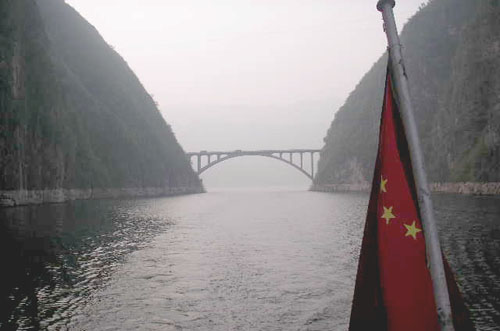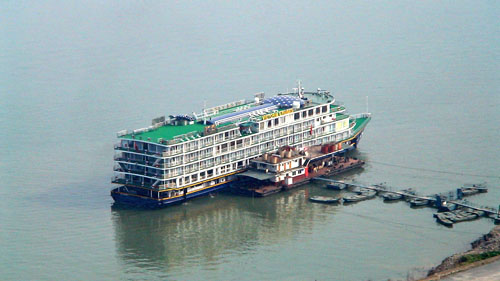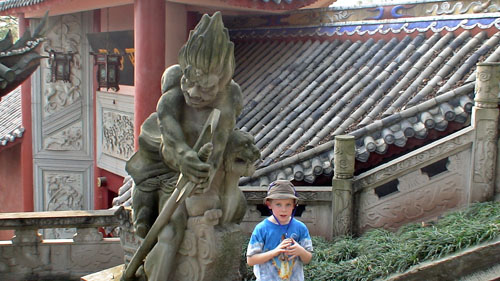
Our Trip
Three months after our arrival in Shanghai, in March, 2007, we took a 3 ½ hour flight to Chongqing – the starting point of a wonderful three day Yangtze River cruise.
We arrived into Chongqing after dark, which is a shame because from what we could see on the way from the airport to the river dock, Chongqing appears to an incredible beautiful city with lots of rolling hills. The city itself boasts over 30 million people and is built on a side of a mountain with an upper and lower level.
Unfortunately though, this history will be forever buried underwater as the Three Gorges Dam – now complete will have displaced millions of farmers whose families worked the land for generations. Entire villages have been submerged and historical artifacts lost forever. When we visited we saw numerous suspended coffins built in caves. It was a custom of the Ba people to bury their loved ones and/or brave warriors. It’s a still a mystery today as how they managed to build the tombs so high on the edge of these cliffs without modern technology. Many of these tombs will be or are now submerged in water due to the Dam being built.
As we ventured through the Three Gorges (fault lines that were the boundaries between kingdoms) and deeper into China, the water became clearer. We would transfer from our small cruise boat to three smaller vessels with the smallest holding about 20 people as we traversed through the narrowing gorges into some of the most beautiful parts of the country. The narrowest part of the trip was only 500 feet wide which is why we had to transfer to small boats. In some places the cliffs towered up to 4,000 feet.
At the end of our three day journey down the Yangtze we came to the Three Gorges Dam in Sandonping. It was raining pretty hard so we hurried through the tour but it was and amazing sight to see.
After touring the dam area and a two-hour drive to the airport it was a two-and-a-half hour flight back to Shanghai and the end of a very long day!.
Fun Facts & Tips

The Yangtze is referred to in China as the dragon river – with the dragon’s tail in Chongqing and its mouth at Shanghai. The river is the third-longest in the world behind the Amazon and the Nile and it cuts through 3,956 miles (6,380 km) and seven provinces before flowing out to the East China Sea.

Chongqing is located in the geographical center of China and is a major starting point for the Three Gorges (Qutang, Wu and Xiling) Cruise. Along this stretch of river are cliffs lined with caves and tombs dating back to the Yellow River Emperor. Wild monkeys swing from tree-to-tree and the one can only wonder what stories can be told from the thousands of years of history – events and scenes depicted in Chinese paintings and lore.
More than one mile long and over 600 feet high the dam cost an estimated $75 billion to build. The Three Gorges Dam raises the river to a level of over 570 feet above sea level. It is an impressive structure, but like many things it came at an extremely large price for the millions that were displaced during the flooding process. The upside is that this dam will help to reduce some of the country’s dependency on burning coal for power. It also aids the economies of inner-China by making goods easier to transport by water instead of unreliable trucks and railways. And, will help with flood control and irrigation.
Welcome to the Yangtze River Cruise, China

We were told once the dam was finished, this bridge would be underwater.

Victoria Star, our ship.
We boarded the Victoria Star ship and had our own private bathrooms and balconies. If you’re going to do a cruise this is a great ship as it had all your basic necessities on board and has a total of 103 cabins so it’s a good size ship. The meals were good and they did an impressive job preparing food for Sean and Sophie (then ages 5 and 7). It was a little chilly in March but we still managed to spend a lot of time on the top deck of the ship enjoying the scenery of the gorges. The ship had nightly entertainment and lectures during the day talking about the dam, the culture and even had a cooking class on how to make dumplings. The kids liked this lot. And, Tai Chi lessons in the early morning. There was always an English speaking person pointing out the important sights along the way and giving us plenty of time to get to the top deck to see it.

This statue facinated Sean so much he insisted I take his picture (Fengdu)..
One of the many stops on our trip was in Fengdu – also known as the “City of Ghosts.” The area has many temples, buildings and statues depicting devils and demons and how the Taoist imagined hell in the afterlife. The history lesson is that during the Tang Dynasty, two locally renowned families, Yin (meaning “hell”) and Wang (meaning “king”) were linked through marriage, making them known as Yinwang or the “king of hell.” It was believed that after one died their spirit would visit Fengdu to receive its fate from the “king of hell” for their afterlife. Sinful people would be downgraded to suffer at hell then reborn as animals or cattle. Sinless people enjoyed time in paradise then were reborn as humans after drinking a memory-kill soup to forget all memories of their past life. Locals have since believed that the town is populated by ghosts.